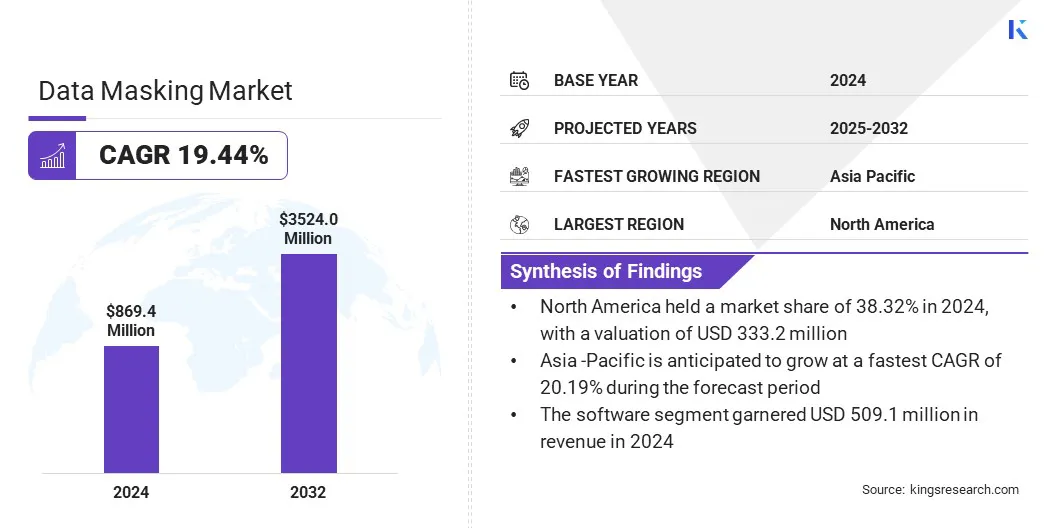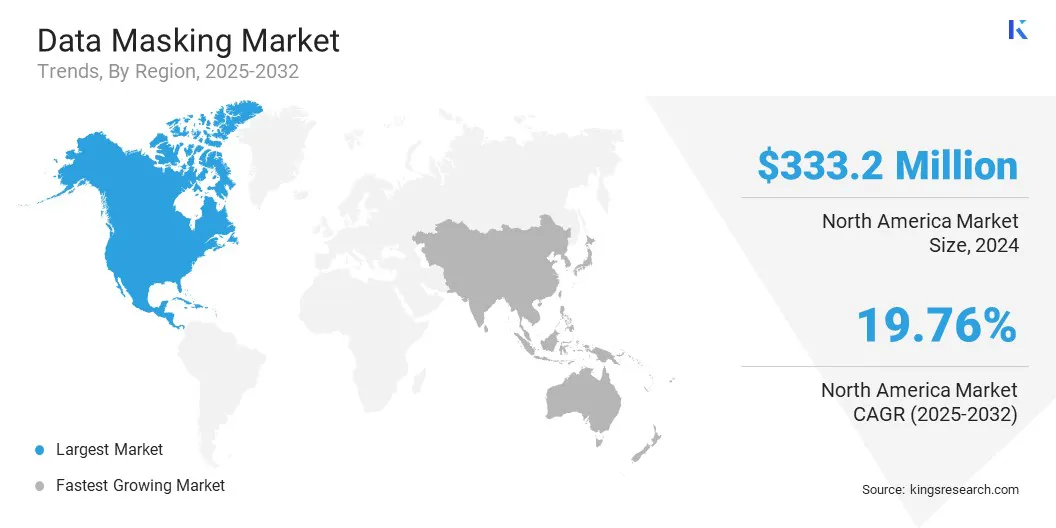Buy Now
Data Masking Market Size, Share, Growth & Industry Analysis, By Type (Static Data Masking, Dynamic Data Masking, Deterministic Masking, Others), By Component (Software, Services), By Deployment Mode (On-premise, Cloud-based), By Organization Size, By Industry Vertical and Regional Analysis, 2025-2032
Pages: 210 | Base Year: 2024 | Release: July 2025 | Author: Versha V.
Data masking is the technique of protecting sensitive information by replacing original data with realistic data. It is commonly used in non-production environments, including development and testing, to ensure that confidential data like personal identifiers, financial records, or health information is not exposed or misused while maintaining usability for functional purposes.
The global data masking market size was valued at USD 869.4 million in 2024 and is projected to grow from USD 1.016.4 million in 2025 to USD 3,524.0 million by 2032, exhibiting a CAGR of 19.44% during the forecast period.
This growth is driven by rising cyber threats and data breaches that are prompting organizations to protect sensitive data in real time through advanced security practices. The market is witnessing notable expansion as enterprises are adopting dynamic data masking to secure live data access while maintaining seamless operations and reducing risk.
Major companies operating in the data masking market are IBM Corporation, Oracle, Hush-Hush, Perforce, Broadcom, Thales, K2VIEW, Protegrity USA, Inc., DATPROF, Innovative Routines International (IRI), Inc., Salesforce.com, Inc., Solix Technologies, Inc., Mage Data, NextLabs, Inc., and DataSunrise, Inc.

The significant surge in e-commerce activities is generating large volumes of customer data, including personally identifiable information (PII), payment details, and behavioral analytics. To secure this sensitive data across testing, analytics, and cloud environments, retailers and e-commerce platforms are increasingly adopting data masking solutions.
Growing Cyber Threats and Data Breaches
The growing rate of cyberattacks across commercial and non-profit sectors is prompting organizations to strengthen their data protection frameworks. Enterprises are increasingly adopting data masking solutions to safeguard confidential data in testing analytics and development environments as data breaches continue to target sensitive information and disrupt operational continuity.
By replacing real data with anonymized or obfuscated versions, organizations are reducing exposure risks while maintaining data usability. This shift support a broader development toward data masking protection across digital operations.
High Implementation Complexity in Large and Diverse IT Environments
The data masking market faces a significant challenge in managing high implementation complexity across large and diverse IT environments. Enterprises operate multiple systems, databases, and applications that vary in architecture and data formats makes it difficult to apply uniform masking rules.
This inconsistency can lead to partial protection and increase the risk of sensitive data exposure. Integrating data masking into legacy infrastructure and coordinating across departments further complicates deployment and requires significant time, technical expertise.
To address this challenge, market players are developing advanced cross-platform data masking solutions that enable seamless integration across complex and varied IT environments. They are adopting automation, AI-based data discovery, and centralized policy controls to apply consistent masking across different systems and applications.
Vendors are introducing pre-built connectors for widely used databases and cloud platforms to simplify implementation. Additionally, companies are strengthening professional services and support to assist with deployment and compliance alignment, helping enterprises reduce complexity and speed up adoption.
Growing Adoption of Dynamic Data Masking
The growing adoption of dynamic data masking is enabling organizations to protect sensitive information in real time as it is accessed, processed, or transmitted across systems. In contrast to static masking, dynamic methods apply context-aware rules that adjust masking based on user roles and usage scenarios.
This approach is increasingly used in AI-powered applications, contact centers, and cloud-based platforms where live data interaction is essential. It supports compliance and data privacy while preserving seamless user experiences in dynamic and distributed digital environments.
|
Segmentation |
Details |
|
By Type |
Static Data Masking, Dynamic Data Masking, Deterministic Masking, Others |
|
By Component |
Software, Services |
|
By Deployment Mode |
On-premise, Cloud-based |
|
By Organization Size |
Large Enterprises, Small and Medium-sized Enterprises |
|
By Industry Vertical |
BFSI, Healthcare and Life Sciences, IT & Telecommunications, Retail & E-commerce, Government & Defense, Others |
|
By Region |
North America: U.S., Canada, Mexico |
|
Europe: France, UK, Spain, Germany, Italy, Russia, Rest of Europe |
|
|
Asia-Pacific: China, Japan, India, Australia, ASEAN, South Korea, Rest of Asia-Pacific |
|
|
Middle East & Africa: Turkey, U.A.E., Saudi Arabia, South Africa, Rest of Middle East & Africa |
|
|
South America: Brazil, Argentina, Rest of South America |
Based on region, the market has been classified into North America, Europe, Asia Pacific, Middle East & Africa, and South America.

The North America data masking market accounted for a share of 38.32% in 2024, valued at USD 333.2 million. This dominance is attributed to the increasing adoption of advanced data protection technologies across industries. Organizations in the region are prioritizing integrated solutions that combine data masking with file security and threat prevention as enterprise workflows increasingly rely on cloud platforms, browsers, and collaboration tools.
Market players are implementing unified platforms that reduce configuration efforts while ensuring consistent protection of sensitive data, supporting regional market expansion. Moreover, enterprises across the region are adopting AI-powered data detection and masking capabilities, contributing significantly to the regional market expansion.
The Asia-Pacific data masking industry is set to grow at a robust CAGR of 20.19% over the forecast period. This growth is attributed to the increasing focus on secure data handling and compliance across the region. Enterprises in the region are accelerating the adoption of automated data protection tools that support the discovery, profiling, and masking of sensitive information.
The regional market is further benefitting from increased implementation of platforms that align with evolving regulatory frameworks and digital transformation initiatives across key industries such as BFSI, healthcare, and life sciences.
Moreover, government support is facilitating wider enterprise and public sector adoption by promoting the deployment of secure and regulatory-compliant solutions that ensure data integrity and regulatory alignment. Organizations across the region are prioritizing scalable solutions that safeguard data throughout the development lifecycle while ensuring operational continuity.
Major players in the data masking industry are expanding their AI infrastructure and cloud platforms by integrating data privacy, governance, and masking capabilities to support secure data flows across cloud environments. They are focusing on building unified architectures that enable context-rich and accurate data management to improve AI-driven applications and enterprise analytics.
Market players are aligning data masking with metadata and quality controls to ensure consistency and transparency across systems. Additionally, they are integrating masking into customer engagement tools and automation workflows to strengthen data security without disrupting user experience.
Frequently Asked Questions